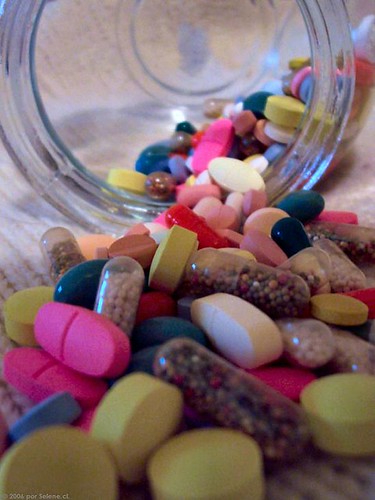Therapy
Or treatment, is the attempted remediation of a health problem, usually following a diagnosis. In the medical field, it is synonymous with the word "treatment". Among psychologists, the term may refer specifically to psychotherapy or "talk therapy".
Preventive therapy or prophylactic therapy is a treatment that is intended to prevent a medical condition from occurring. For example, many vaccines prevent infectious diseases. Anabortive therapy is a treatment that is intended to stop a medical condition from progressing any further. A medication taken at the earliest signs of a disease, such as at the very symptoms of a migraine headache, is an abortive therapy.
A supportive therapy is one that does not treat or improve the underlying condition, but instead increases the patient's comfort. Supportive treatment may be used in palliative care.
Overtreatment is an overutilization, a treatment that is unnecessary or disproportionate to the situation. For example, the treatment of a condition that causes no symptoms and will go away on its own is overtreatment. Similarly, extensive treatment for a condition that could be remedied with very limited treatment is overtreatment. Overtreatment may be caused by overdiagnosis, the identification of harmless abnormalities.
Immunotherapy
is a medical term defined as the "treatment of disease by inducing, enhancing, or suppressing an immune response". Immunotherapies designed to elicit or amplify an immune response are classified as activation immunotherapies. While immunotherapies that reduce or suppress are classified as suppression immunotherapies.
Cell based Immunotherapies are proven to be effective for some cancers. Immune effector cells such as lymphocytes, macrophages, dendritic cells, natural killer cells (NK Cell), cytotoxic T lymphocytes (CTL), etc., work together to defend the body against cancer by targeting abnormal antigens expressed on the surface of the tumor due to mutation.The active agents of immunotherapy are collectively called immunomodulators. They are a diverse array of recombinant, synthetic and natural preparations, often cytokines. Some of these substances, such as granulocyte colony-stimulating factor (G-CSF), interferons, imiquimod and cellular membrane fractions from bacteria are already licensed for use in patients. Others including IL-2, IL-7, IL-12, various chemokines, synthetic cytosine phosphate-guanosine (CpG), oligodeoxynucleotides and glucans are currently being investigated extensively in clinical and preclinical studies. Immunomodulatory regimens offer an attractive approach as they often have fewer side effects than existing drugs, including less potential for creating resistance in microbial diseases.
Disease control
Collaborating to create the expertise, information, and tools that people and communities need to protect their health – through health promotion, prevention of disease, injury and disability, and preparedness for new health threats.
seek to accomplish its mission by working with partners throughout the nation and the world to
- monitor health,
- detect and investigate health problems,
- conduct research to enhance prevention,
- develop and advocate sound public health policies,
- implement prevention strategies,
- promote healthy behaviors,
- foster safe and healthful environments,
- provide leadership and training.
Those functions are the backbone of CDC′s mission. Each of CDC′s component organizations undertakes these activities in conducting its specific programs. The steps needed to accomplish this mission are also based on scientific excellence, requiring well-trained public health practitioners and leaders dedicated to high standards of quality and ethical practice.
Medication Administration Route
Medication route refers to the way that a drug is introduced into the body.
This is based on the specific medication being used, the rate of absorption desired and the specific site of action (where the medication needs to have an effect).
Most drugs are manufactured for a specific route of administration and must be used as directed for safety and efficiency.
Some examples of routes of administration include:
Oral: Medications are taken by mouth (in pill, capsule or liquid form) and absorbed into the system through the digestive system. Absorption is slow. Medications that use this option cannot be used if vomiting is occurring.
Enteral: Medications are administered into the rectum (via a suppository) and absorbed by the lower digestive tract.
Mucosal: Medications are delivered through the nose or inhaled and are absorbed through the nasal mucosa or bronchioles, respectively. Vaginal administration of a medication is also considered mucosal.
Parenteral: Any medication administration that involves injecting a drug directly into a vein (intravenous), muscle (intramuscular), artery (intrarterial), abdominal cavity (intrperitoneal), heart (intracardiac) or into the fatty tissue beneath the skin (subcutaneous). The speed of absorption varies but is faster than oral administration. This is used when more complete and faster absorption of a drug is needed.
Percutaneous: Medications are absorbed directly through the skin into the blood stream. Some hormone replacements are administered by patches that are absorbed slowly and evenly, for example.
Pharmaceutical drug
also referred to as medicine, medication or medicament, can be loosely defined as any chemical substance intended for use in the medical diagnosis, cure, treatment, or prevention of disease. The word pharmaceutical comes from the Greek word Pharmakeia. The modern transliteration of Pharmakeia is Pharmacia
Medications can be classified in various ways, such as by chemical properties, mode or route of administration, biological system affected, or therapeutic effects. An elaborate and widely used classification system is the Anatomical Therapeutic Chemical Classification System (ATC system). The World Health Organization keeps a list of essential medicines.
A sampling of classes of medicine includes:
- Antipyretics: reducing fever (pyrexia/pyresis)
- Analgesics: reducing pain (painkillers)
- Antimalarial drugs: treating malaria
- Antibiotics: inhibiting germ growth
- Antiseptics: prevention of germ growth near burns, cuts and wounds
.







No hay comentarios:
Publicar un comentario